Horizontal surfaces exposed to the weather can be difficult to waterproof. Inadequate slope can create areas of standing water.
In colder climates, freeze/thaw cycles impose additional challenges. Frequently, it has to stand up to foot traffic as well.
Fortunately, products are available that seal everything from pool decks to high-rise balconies. Whether the project is a small private patio or a sprawling rooftop gathering place, the goal is the same: Directing the water off the deck while keeping the substrate dry.
Wooden Decks
The most common residential decking material is wood. Historically, this type of deck has been made with redwood or cedar. More recently, composite materials have been developed that offer a wider range of colors and reduced maintenance. Regardless of the material used for the decking surface and railing, the joists and support posts are nearly always construction-grade lumber, which is susceptible to rot.

To address this issue, the North American Deck and Railing Association (NADRA) recommends checking the wood annually. Their checklist states, “Check several different areas of the deck to be sure the wood is still sound. This includes the ledger board (where the deck attaches to the house), support posts and joists under the deck… Pay special attention to any areas that tend to remain damp, are regularly exposed to water, or are in contact with fasteners.”
Wooden deck supports will last longer if protected from moisture, and proper flashing plays a vital role. NADRA explains, “Flashing is a metal or plastic guard that directs water out and away from sensitive areas. It’s often installed where the deck and house come together, keeping moisture and debris from collecting between the house and the deck’s ledger board. Be certain the flashing is sound and firmly in place. Consider adding or replacing flashing if you notice areas that are obviously allowing water to collect.”
MFM Building Products recently introduced a peel-and-stick membrane specifically designed for deck flashing. Called DeckWrap PowerBond, it’s a self-adhering waterproofing membrane ideal for protecting ledgers, joists, and posts from premature rot and degradation.
The membrane bonds aggressively to wood or metal surfaces even at temperatures as low as 25°F. The membrane also is self-sealing around nails, screws, punctures and other fasteners to prevent water penetration and extend the life of the deck. It also stops the corrosion of metal components that come in contact with ACQ-treated lumber.
It comes in 75-foot rolls in widths of three, six, and 12 inches, and can be easily installed by professional contractors and “do-it-yourself” homeowners. The only tool required is a sharp utility knife.
PVC Roof Decks
Occasionally, a developer or homeowner wants a walkable rooftop living space. These rooftop decks often have a plywood substrate, and can be challenging to waterproof due to the foot traffic and movement in the underlying substrate. Additionally, leaks in this application are often catastrophic, as moisture can penetrate the living quarters beneath.
Demand for this sort of decking is increasing, as rooftop decks add considerable value to the property. In urban developments, where outdoor living space is otherwise very rare, they allow occupants to “develop their own little oasis of pleasure by converting flat roofs into rooftop decks that require very little maintenance.”

Decks areas add value to multifamily apartments. Waterproofing them requires careful attention to detail.
A number of different product types are used to seal this type of deck, including urethanes and polyureas, fiberglass, and composite systems based around self-adhered “peel-and-stick” membranes. Perhaps the easiest and most popular method for residential and multi-family applications is sheet vinyl (PVC).
The University of California Davis chose sheet vinyl when they wanted to create an outdoor leisure space on a flat roof atop the student union building. With offices underneath, and considerable foot traffic above, the surface had to be durable, attractive and absolutely waterproof.

UC Davis chose sheet vinyl to create a rooftop deck atop the student union building.
Vinyl decking products are available from a number of companies, but for this application they chose Global Decking’s PVC sheet membrane, which could provide both a roof and a patio surface in a single product. Brendan Houle, director of business development at Global Decking, explains, “Typically to create a patio space on a flat roof, a roofing surface such as PVC, TPO or EPDM is installed. [But] these surfaces are not approved for use as a walking surface, therefore a walking surface such as composite deck boards are floated on top. These extra steps not only cost more but if there is ever a leak, the top surface has to be removed before the membrane under can be repaired. Global Decking walkable membranes act as both the roof and the walking surface.”
The chosen product has a proven track record of use in high traffic areas, and is widely used on sun decks, balconies, walkways, restaurant patios and flat roofs. The membrane included a slip-resistant embossing for greater traction, and will last upwards of 20 years on a typical project. The product was installed in 2006.
Last year, Houle contacted the maintenance manager for the university, who had been involved in the project when the deck was installed 11 years earlier. He reported the rooftop patio continues to meet original criteria and remains a high use area.
Houle adds, “Our PVC sheet membranes are maintenance free, and will never leak, rot or breakdown. Our vinyl is engineered with 150% multi-directional expansion to easily accommodate quick changes in temperature, and have a warranty of up to 15 years.”
Concrete Decks
Even concrete surfaces, which appear to be impervious to water, can benefit from waterproofing, especially on pool decks. Aaron Steele, digital marketing manager for Latham Pool Products, writes, “One of the most important swimming pool features isn’t actually in the pool, it’s around it. The look of your pool deck can have major influence on your enjoyment of the pool. Nothing is more disappointing than seeing your beautiful, sparkling pool surrounded by a deteriorating deck. That’s why it’s important to waterproof and protect your deck surface.”
Before any waterproofing or overlayment can be installed, the concrete substrate must first be stabilized.

This historic beachside swimming pool was stabilized with polyurethane resin.
If there are major voids under the deck or pool, they can often be filled and stabilized by injecting polyurethane grouts. For instance, polyurethane grout was used to stabilize a 130-year-old beachside swimming pool in Sydney, Australia. It’s so close to the ocean that the pool is filled naturally twice a day with fresh seawater at high tide. Unfortunately, age and massive storms in 2015-16 left the pool in need of repair. The city council hired a local contractor, who discovered that the pool had to be stabilized and dried out prior to refinishing. To seal the cracks and voids, they used a hydrophobic polyurethane resin from Prime Resins. The product cures into a hard, watertight mass, and is NSF/ANSI Standard 61-certified for contact with potable water. Kevin Anthony, director of marketing at Prime Resins, says, “While drinking water was not involved, the pool’s location in the ocean made choosing the eco-friendly product an easy decision.”
Technicians drilled a pattern of 10mm x 400mm deep holes on either side of the leaking seams and cracks and injected approximately 500 liters of Prime Flex 920. This filled all the voids under the pool and sealed the leaks as the resin traveled up through the defects.
The grouting worked perfectly and allowed other crews to successfully resurface the entire pool. Today the pool is clean, gleaming and safe.

Carbon fiber stabilized the cracks in this pool deck to ensure the decorative topping stays pristine.
To stabilize cracks in pool decks and any other vertical or horizontal concrete, Rhino Carbon Fiber recently debuted a new dumbbell-shaped carbon fiber staple that makes crack repair faster, cleaner, and stronger than ever before. In the past, contractors often resorted to bending rebar into the shape of a staple, and then drilling and grinding the concrete until these giant “staples” sat flat across the crack. The new method is far easier and reliable. Jarred Jones says, “Instead of relying on the strength of the epoxy, this pre-cured carbon fiber repair product locks directly into the concrete and transfers the load directly.”
They were used to repair the pool deck at the Summerset Country Club in Brentwood, California before coating the entire deck with a LiquidStone product.
Summary
Whether it’s a pool deck, high-rise balcony, small private patio or a rooftop deck on a university campus, the demand for reliable deck waterproofing products and skilled installation contractors has never been higher.
Waterproofing contractors and repair specialists can easily diversify into this profitable and growing sector thanks to the range of innovative products now available to repair and seal wood and concrete deck surfaces. Σ
Spring 2018 Back Issue
$4.95
Hybrid Sealants for Crack Repair
AVAILABLE AS DIGITAL DOWNLOAD ONLY
Description
Description
Additional Info
Additional information
| Magazine Format | Digital Download Magazine, Print Mailed Magazine |
|---|

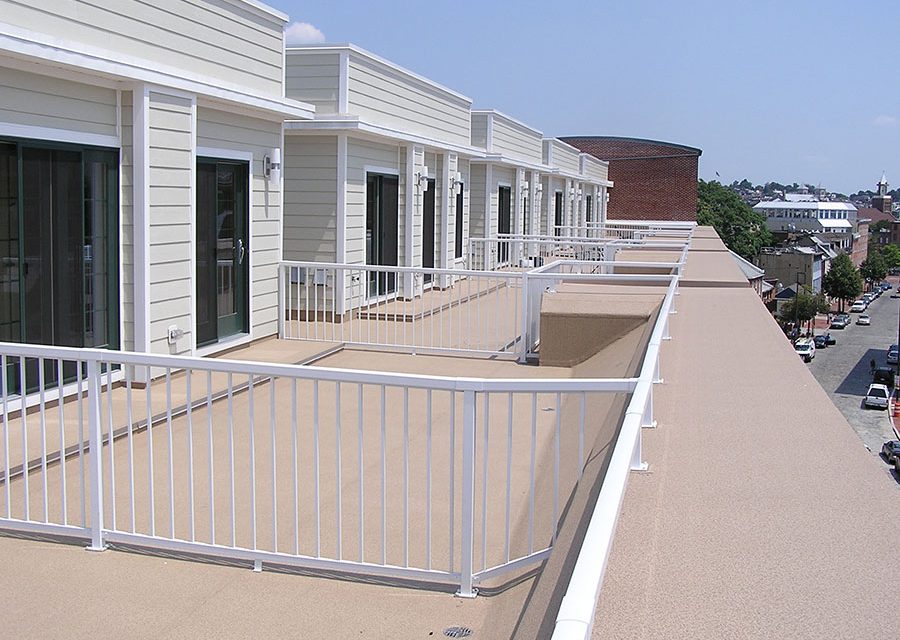
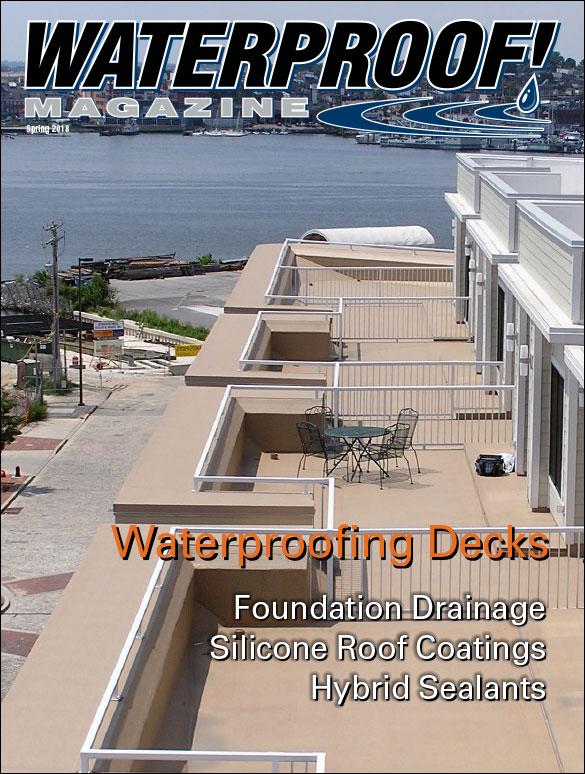

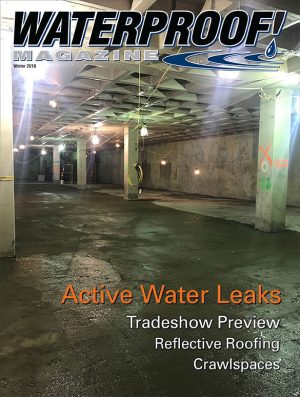
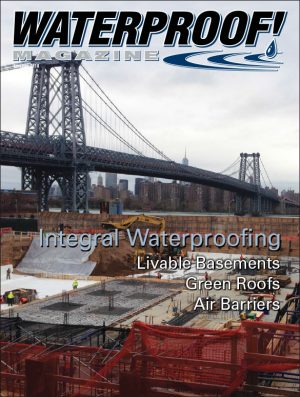



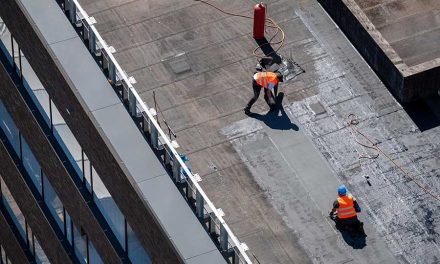










I didn’t know that concrete decks can benefit from waterproofing too. I kind of figured they were already waterproof. I’d love to get a deck like that for the summer so it will match the pool I’m getting built.